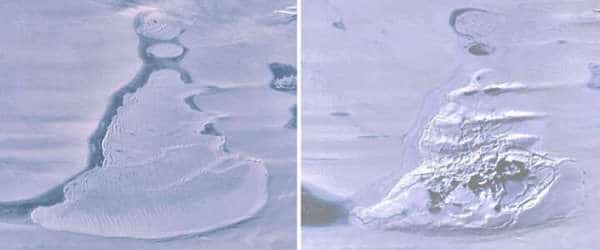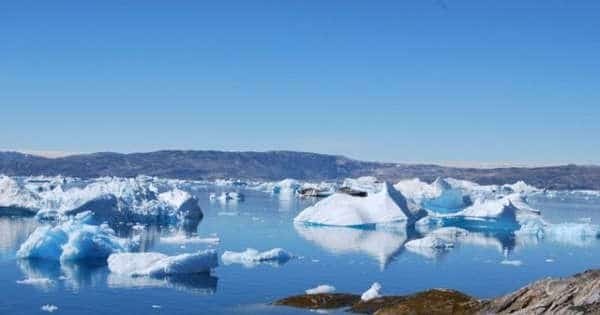A massive Antarctic lake mysteriously vanished, carrying more water than Lake Erie with it as it sank into the ocean. The lake vanished by causing a massive fissure in the ice beneath it. Researchers observed its demise via satellite imagery before and after the 600–750 million-cubic-meter (21–26 billion cubic feet) lake drained through the ice shelf below, and they believe it could reveal a lot about the stability of large bodies of ice in the region.
All that is left is a crater and a fractured ice cover where the lake once stood.
Although the researchers are unsure how the lake vanished in such a short period of time, the bottom of the lake fracturing under the intense pressure is the most likely scenario. Their findings were published in Geophysical Research Letters.
“We believe the weight of the water accumulated in this deep lake opened a fissure in the ice shelf beneath the lake, causing the water to drain away to the ocean below,” said lead author Roland Warner, a glaciologist with the Australian Antarctic Program Partnership at the University of Tasmania, in a statement.
Researchers witnessed its demise from satellite imagery before and after the 600–750 million-cubic-meter lake drained through the ice shelf below, and believe it could tell scientists a lot about the stability of large bodies of ice in the region.
The Amery Ice Shelf is the third-largest in Antarctica, reaching 1,800 meters in some places. This lake was in the upper part of the area, where the ice was more than 1,400 meters thick. While it is not uncommon for lakes to be drained by this phenomenon, scientists did not expect it to occur at such a great depth of ice.
The Amery Ice Shelf, which faces the South Indian Ocean, is the third-largest shelf in Antarctica, with some areas reaching 1,800 meters (5,900 feet) thick. This lake was located on top of the Amery Ice Shelf, where the ice was approximately 1,400 meters (4,590 feet) thick. It is not uncommon to see lakes drained by hydrofracture, and scientists have identified many ice shelves in Antarctica that may be vulnerable to it, but it is not expected to happen at such great depths.
The researchers hope to use this information, as well as the state-of-the-art satellites that captured the lake’s grizzly demise (aptly named ICESat-2), to further their understanding of the degradation of Antarctic ice shelves.

“It is exciting to see ICESat-2 reveal details of processes occurring on the ice sheet at such fine spatial scales,” said co-author Helen Amanda Fricker, a glaciologist at Scripps Institution of Oceanography, in a statement.
“Because surface meltwater on ice shelves can cause their collapse, which eventually leads to sea-level rise when grounded ice is no longer held back, understanding the processes that weaken ice shelves is critical.”
While the edges of Antarctica, as well as the rest of the world, are currently experiencing unprecedented heat, the researchers are unable to conclude that climate change is to blame. It would certainly make sense, given that even the most inhospitable places on Earth are feeling the heat, with temperatures in the Arctic Circle recently reaching 48 °C.
The team hopes to use all of the data gathered to better understand the process of ice shelf degradation in Antarctica. “Because meltwater from the surface on the platforms can cause their collapse, which ultimately leads to a rise in sea level when the ice on land is no longer retained,” said Amanda Fricker, a glaciologist at the Scripps Institution of Oceanography.
While the world is experiencing unprecedented heat, researchers cannot conclude that climate change is to blame for the lake’s disappearance at this time. In any case, they recall that as temperatures have risen in recent decades, some ice shelves’ surfaces have melted more rapidly, increasing the risk of a widespread hydrofracture.
















